Best Time for Lobuche East Peak Climb
The best time for Lobuche East Peak Climb is during spring (March to May) and autumn (September to November). These two seasons provide stable weather, crystal-clear skies, and the most favorable conditions for trekking and climbing. Spring brings warmer days, rhododendron blooms, and excellent visibility, while autumn offers dry trails, fresh greenery after the monsoon, and breathtaking Himalayan views. Both seasons ensure a safe, comfortable, and rewarding Lobuche East adventure with fewer weather-related risks compared to summer or winter.
Spring and Autumn Seasons
In spring, March still has cold nights and some lingering snow, but April and May are perfect for Lobuche East Peak Climbing. April is especially popular, with mild temperatures, longer days, and colorful forests. In autumn, September starts a bit wet due to the end of the monsoon, but the trails quickly dry up and turn vibrant. October is widely considered the best month for the climb with clear skies, stable weather, and moderate temperatures. November remains excellent; though nights at higher altitudes can get freezing, so proper gear and guidance are essential.
Winter and Summer Seasons
Climbing in winter (December to February) or summer/monsoon (June to August) is possible but far more challenging. Winter brings extreme cold, heavy snow, and closed teahouses at high altitudes, making it suitable only for experienced climbers with strong preparation. Summer is the rainy season, causing muddy trails, landslides, slippery paths, and reduced visibility. Despite these challenges, summer offers lush green landscapes and fewer crowds, while winter promises solitude and a true adventure. Both require an experienced guide, porter, and high-quality climbing gear for safety and success.
Lobuche East Peak Climb - Cost
The cost for the Lobuche East Peak Climb is USD 2,350 per person, based on a minimum of two participants in our standard itinerary. The itinerary is 13 days from Kathmandu to Kathmandu, including 3 nights in Kathmandu.
We highly recommend that trekkers add 4 extra buffer days—2 days before the trip and 2 days after—to account for possible weather delays.
This cost includes for Transportation, Accommodation, Meals, Professional trekking and climbing guide, Climbing equipment, tented camps, required porters, all necessary permits for the climbing.
Not included: emergency evacuation, personal trekking and climbing gear, snacks, all types of drinks, and additional luxury services.
The final price may vary depending on factors such as the trekking and climbing season, group size, itinerary selection, and the level of service you prefer.
We guarantee reasonable pricing and high-quality service for the Lobuche East Peak Climb. Our packages are transparent and competitive with no hidden costs, ensuring the best value for your money. All essential services are included, making your planning and budgeting straightforward and hassle-free.
Lobuche East Peak Climb – Difficulty
Lobuche East Peak (6,019 meters) is considered a moderately challenging climbing peak in Nepal, making it ideal for adventurous trekkers and beginner climbers with good physical fitness and basic mountaineering skills. The climbing route includes rocky terrain, glacier crossings, steep snow and ice slopes, and requires the use of equipment such as climbing boots with crampons, harnesses, helmets, ascenders, descenders, and fixed ropes. Prior experience with high-altitude trekking and basic training in rope handling and ice climbing are highly beneficial, but advanced technical climbing experience is not mandatory.
Other challenges include walking 5 to 8 hours daily over 13 days on ascents and descents at high elevations, which is why acclimatization days are necessary. At times, weather conditions such as snowfall or rainfall can add extra difficulty, especially at higher altitudes. Therefore, a strong fitness level, positive mindset, and determined attitude are essential for successfully reaching the summit. In addition, proper acclimatization, the right seasonal gear, and the guidance of an experienced trekking and climbing team—with porter support—are strongly recommended for a safe and successful Lobuche East Peak climb, free from unnecessary hassles.
Lobuche East Peak Climb – Permits and Permits Cost
Lobuche East Peak trekking and climbing requires several permits, as the route lies within Sagarmatha National Park and the Khumbu Pasang Lhamu Rural Municipality in the Everest region of Nepal. Therefore, trekkers and climbers must obtain and carry a Sagarmatha National Park entrance permit, a Khumbu Pasang Lhamu Rural Municipality entrance permit, and a Lobuche East Peak climbing permit.
These permits can be obtained from the Tourism Board (Bhrikuti Mandap) for the Sagarmatha National Park entrance permit. From the Nepal Mountaineering Association in Naxal Kathmandu for the Lobuche East Peak climbing permit, usually through a reputable trekking company. The Khumbu Pasang Lhamu Rural Municipality entrance permit must be purchased in Lukla after starting the journey.
You or your guide must carry these permits throughout the trek and climb, as they need to be shown and registered at every checkpoint along the trail. If you attempt the trek or climb without these permits, you will be required to purchase them on-site at double the cost (as a penalty) or risk being turned back. However, the Lobuche East Peak climbing permit must be obtained in Kathmandu, and without it, climbing Lobuche East Peak is strictly not allowed.
Requiring permits are given below:-
Khumbu Pasang Lhamu Rural Municipality entrance permits
- Cost: US$ 30 per person, per trek for all foreigners
- Cost: US$ 20 per person for SAARC (South Asian Association for Regional Cooperation) citizens
TIMS (Trekkers Information Management System) Card:
- Cost: US$ 20 per person, per trek
Sagarmatha National Park Entrance Fees:
- Cost: US$ 30 per person, per trek for all foreigners
- Cost: US$ 15 per person for SAARC (South Asian Association for Regional Cooperation) citizens
Lobuche East Peak Climbing Permits:
- Cost: US$ 125 per person for December, January, February, June, July, and August
- Cost: US$ 175 per person for September, October, and November
- Cost: US$ 300 per person for March, April, and May
Lobuche East Peak Climb - Accommodation
Accommodation options along the Lobuche East Peak trekking and climbing route are generally basic and provided by tea houses and lodges due to the region’s remote and rugged nature, with one night spent in a tent camp at Lobuche East Peak Base Camp. Normally, lodges offer simple private rooms (typically with two beds per room) for twin sharing, equipped with beds, blankets, and pillows. In some areas, teahouses are limited and offer only a few rooms, while in popular places such as Namche, Lukla, and Dingboche, there are plenty of accommodations, including some with luxury facilities.
Bathrooms are usually shared indoor facilities with squat toilets, and hot showers are sometimes available, often powered by solar energy or gas geysers, for an additional charge. Charging electronic devices is generally possible for a fee, though carrying a power bank is recommended. Every lodge has a communal dining area with a heater, especially at higher altitudes, where trekkers can eat, relax, and socialize. During peak season, it can be challenging to find available rooms in certain areas, but guides usually manage this by making advance bookings over the phone.
Lobuche East Peak Climb – Food
Food options along the Lobuche East Peak trekking and climbing route generally consist of local Nepali and Sherpa dishes, with some basic Western meals available in most tea houses and lodges. For the one night spent at Lobuche East Base Camp in a tent camp, meals are simple and prepared by the guide and porter.
Nowadays, every teahouse provides a food menu, and the items are usually quite similar across different locations. Trekkers can select meals from the menu according to their preferences. The cooks are generally trained and often hired from urban areas to prepare quality meals for trekkers and climbers, though the taste may differ from typical Western cuisine.
It is advisable to follow a vegetarian diet during the Lobuche East Peak Climb, as obtaining fresh meat is difficult in this remote region, and most local communities along the trail are predominantly Buddhist.
Common food items available include:
Local Nepali and Sherpa food:
- Dal Bhat: A staple dish served to accompany, consisting of rice served with lentil soup (dal), seasonal vegetables, and pickle.
- Momos: Steamed or fried dumplings filled with vegetables, tuna fish, cheese, eggs, potatoes, or a mix, served with dipping sauces.
- Thukpa: An energetic noodle soup with vegetables and sometimes eggs, flavored with local spices.
- Tibetan Bread: Flatbread fried or baked, often served with honey jam or butter for breakfast or as a snack.
- Tsampa: Roasted barley flour, eaten as porridge or mixed with butter tea (suja). It looks similar to baby food.
Western and International Options:
- Pasta and Noodles: Available in tea houses, often prepared with local ingredients and sauces.
- Omelets: Commonly served for breakfast with items like omelet, fried, boiled, poached eggs, accompanied by Tibetan bread or toast.
- Potatoes and Vegetables: Sometimes served as standalone dishes or as sides with main meals, featuring various varieties flavored with local spices.
Beverages:
- Hot Drinks: All types of hot drinks such as tea, coffee, hot lemon, lemon ginger honey, and hot chocolate are available throughout the trek, but they are often served without sugar; sugar will be provided separately.
- Soft Drinks: Carbonated beverages like cola and Sprite, as well as bottled water, are available throughout the trek.
Tipping information for Trip Staff
The trekking and climbing guide, as well as the porter, is essential to the success of the trip, ensuring that it is completed smoothly and without issues. Tipping is an important aspect of trekking in Nepal, as it acknowledges and appreciates the hard work of the local staff who assist you throughout your journey. It is customary to tip at the end of the trek, and you should gather all team members (guide, porter, assistant guide) together to distribute the tip. Tips are generally given in cash, preferably in US dollars or Nepalese rupees, and it is best to use small denominations to facilitate easier distribution
While the typical guideline is to tip around 10% of the total payable amount, you can adjust this based on the quality of service provided. Recommended tipping amounts are as follows:
- Guide: $12-$15 per day
- Climbing Guide: US$ 80 total
- Porter: $8-$10 per day
- Assistant Guide: $8-$12 per day
These tips are highly recommended to motivate the team and reward them for their outstanding service, contributing to a memorable and inspiring experience.
Required packing list for Island Peak Trekking and Climbing
Travel equipment is essential to pack before your trip. Below is the recommended packing list. We understand it may seem like a lot to carry from home, so we suggest packing light and bringing only the necessary items. If you’re missing something, you can hire or buy it in Kathmandu, especially around Thamel.
These general items are suitable for all seasons while trekking in Nepal, but the list may vary depending on the season and the duration of your chosen trek. Therefore, it’s important to ask your trekking organizer for a detailed packing list specific to your trek. They will provide you with clear information about what to bring.
Climbing gears
- Climbing Boots: Should be insulated, waterproof, sturdy, and good ankle support
- Crampons: Make sure, compatible with your climbing boots and in good condition.
- Ice Axe: A basic ice axe is essential for traversing snow and ice sections.
- Harness: A comfortable and adjustable climbing harness is necessary for safety.
- Helmet: A climbing helmet to protect your head from falling rocks and ice.
- Ropes: You might need a rope for glacier travel and crevasse crossings. It will be provided by your trekking agent.
- Carabineers: A mix of locking and non-locking carabineers for various purposes.
- Ascenders and Descenders: These are used for ascending and descending on ropes
Climbing clothes
- Base Layers: Moisture-wicking base layers (both top and bottom) to keep you warm and dry.
- Insulating Layer: A good quality fleece or down jacket for warmth
- Outer Layer: A waterproof and windproof shell jacket and pants.
- Gloves: Layered gloves including thin liners and thick, insulated gloves for cold weather.
- Hat and Balaclava: For warmth and protection against the cold.
- Gaiters: To keep snow and ice out of your boots.
Necessary Trekking gear
Documents:
- Passport and 4 passport size photos
- Travel insurance details (in case an emergency evacuation if needed)
- Boarding passes for flights
- Driver’s license (if needed)
- Cash USD
- Credit/Debit Card (Ensure you have $500 on your card incase an emergency helicopter evacuation is needed)
Sleeping:
- Sleeping bag (Comfort rating -15 Celsius recommended)
- Sleeping bag liner (Optional)
Footwear:
- Trekking boots: one pair lightweight
- Sandals for city and tea house footwear
- Shoes for the plane and tea houses (Optional)
- Gaiters for hiking in winter to the base camp
- Thin, lightweight inner socks
- Thick, warm wool hiking socks
Clothing for Body:
Please make sure that you have non-cotton clothing for trekking:
- Base-layer t-shirts (e.g. running t-shirts)
- Fleece/Windproof jacket
- Waterproof jacket
- Down jacket for warmth
- Underwear
- Base-layer trousers (optional)
- Waterproof trousers
- Trekking trousers
- Trekking shorts (Optional)
- Gloves and wool hat
- Bandanna or scarf
Health Requirements (Basic First Aid Kit)
- First-aid kit; should contain lip salve, Aspirin, Band Aids, anti-histamine, Imodium or similar tablets for mild cases of diarrhea
- Re-hydration powder, extra prescription drugs you may be taking if any particular
- Wet wipes for cleaning can be purchased in Kathmandu
Others:
- Sunglasses and Sun cream
- Towel
- Book (reading and writing materials)
- MP-3 /Music, headphones and ear plug (who know some people on group are snoring) as optional.
- Travel wash
- Hand sanitizer, wet wipes
- A day bag: 35 liters
- A duffel or rucksack with straps to go over your back (Max 12 kg of weight for porters to carry)
- Dry Liner or Dry Bag
- Water bottle/thermos/ camel bag: At least 2 L. Nalgen bottles best.
General Toiletries
- Toilet papers/ tissue
- Contact lenses, Glasses (if needed)
- 1 medium sized quick drying towel
- Tooth brush/paste (preferably biodegradable)
- Multipurpose soaps (preferably biodegradable)
- Nail clippers
- Face and body moisturizer
- Feminine hygiene products
- Small mirror
- On Personal Hygiene
- Wet wipes (baby wipes)
- Anti-bacterial hands wash
Others (optional)
- Trekking Poles
- Large plastic bags – for keeping items dry inside your kit / duffel bag
- Travel game i.e. chess, backgammon, and scrabble. (For luxuries)
- Binoculars (for luxuries)
- Trail Map/Guide book (if you are alone)
High altitude sickness information
Mountain sickness is another name for high altitude sickness. You must be aware of high altitude sickness symptoms since they arise rapidly if you hike or ascend to a higher elevation. Here are some details if you're curious as to why it occurs. The air pressure is the main cause of altitude sickness. Your body needs time to adapt to the shift in air pressure when you travel to higher elevations since the air pressure decreases and there is less oxygen present. According to doctors, If you are at sea level, it begins at 8,000 feet (2400 meters).
1) Types
There are three types of altitude sickness:
Acute Mountain Sickness (AMS): it is very common and symptoms feel like a tiredness, dizzy, headache, thirsty, muscle aches, nausea
High Altitude Pulmonary Edema (HAPE): it is effect in the lungs, which can be very dangerous and hard to do life threatening
High Altitude Cerebral Edema (HACE): it is effective in the brain and most difficult to treat and you need to go to hospital attention the right way.
2) Cause
Following are the causes of high altitude sickness:
Generally living near sea level and travel to a high elevation
Had the sickness before
Climbing quickly
Not being acclimatized to the altitude
Drinking alcohol when you ascend
Medical problems of heart, nervous or lungs
3) Symptoms
These symptoms will appear depending on your speed to climb and how hard you push. Symptoms range from normal to serious. They can affect the nervous system, lungs, muscles, and heart.
Here are symptoms of High Altitude Sickness:
Difficulty sleeping
Dizziness
Fatigue
Headache
Loss of appetite
Nausea or vomiting
Rapid Pulse (Heart Rate)
Short breath with action
Blue color of skin or gray soft skin
Chest tightness or blocking
Confusion
Dry cough or coughing with blood
Cannot walk in a straight line
4) Prevention
Important keys to preventing of High Altitude Sickness are:
Climb the mountain gradually.
Stop every 2,000 feet (600 meters) of climb above 8,000 feet (2,400 meters) and one or two nights sleep there.
Sleep at a lower altitude when possible.
Make sure that you have the ability to quickly descend if needed.
Learn how to recognize early symptoms of mountain sickness.
If you plan on climbing quickly, or climbing to a high altitude, ask your provider about medicines that may help.
If you are at risk for a low red blood cell count (anemia), ask your provider if your planned trip is safe. Also ask if an iron supplement is right for you. Anemia lowers the amount of oxygen in your blood. This makes you more likely to have mountain sickness.
5) While climbing, you should follow these rules:
Drink plenty of water
Climb slowly.
Take it easy
Do not drink alcohol.
Eat regular meals that are high in carbohydrates.
Sleep lower elevation
Take a medication (diomax) according to doctor


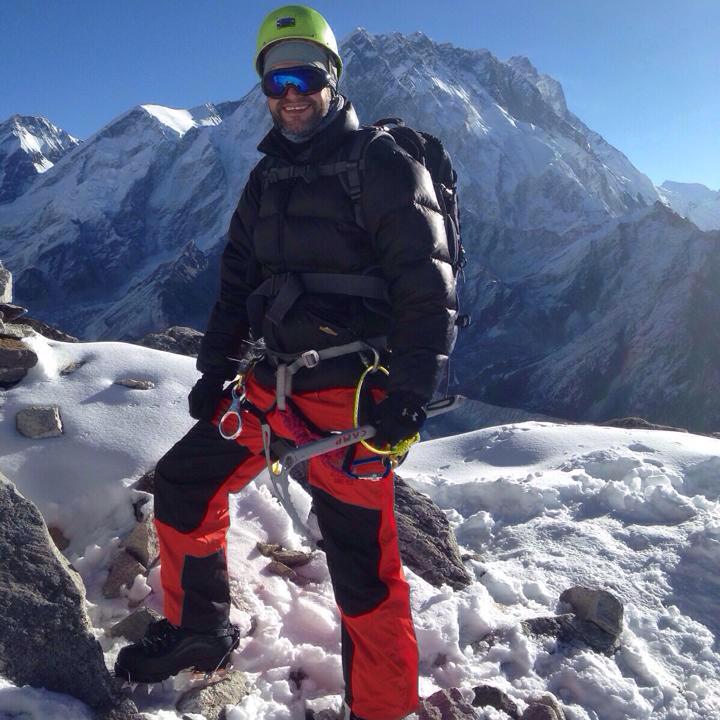

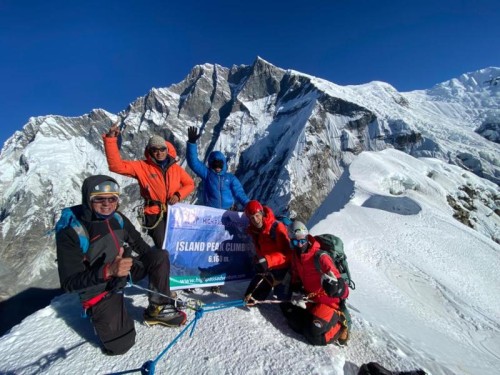


 USD 2250
USD 2250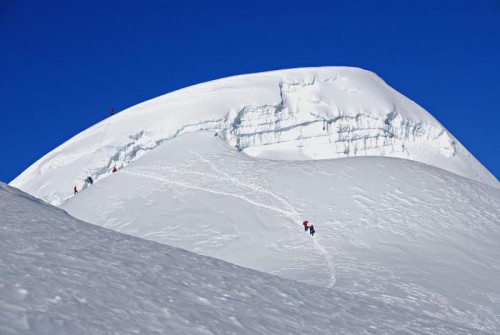

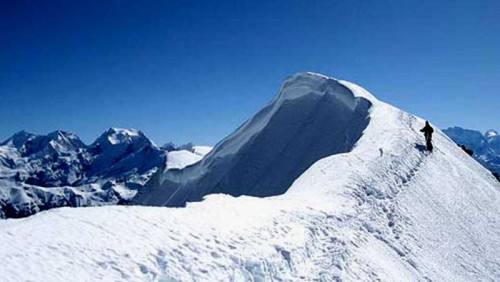
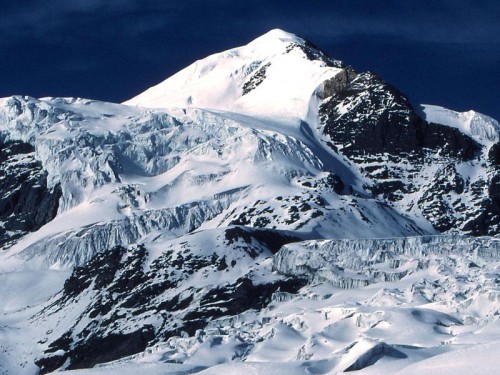


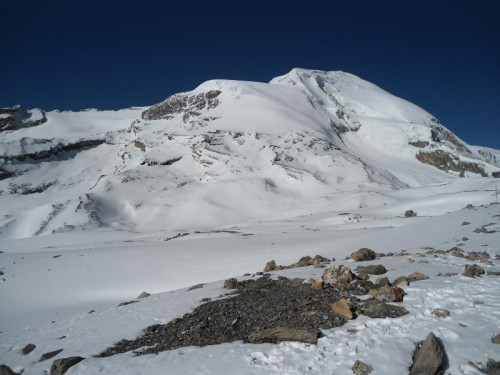
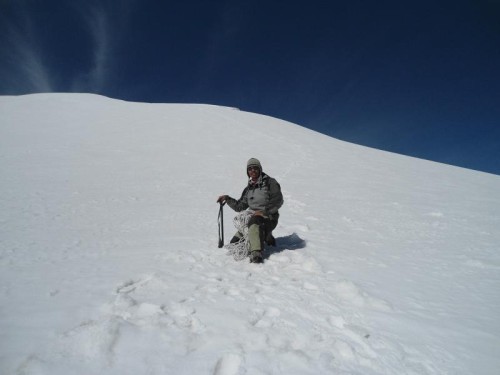
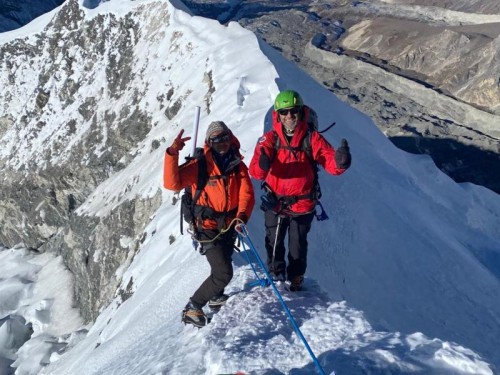

Lan
United Kingdom
The Guide to Happiness
14th June, 2023
I would highly recommend High Pass Adventure and Purna to be your guide wherever you’re planning a trek in Nepal. From the moment he met us at Katmandu airport with a huge smile, to leading us up to Lukla and towards Lobouche east we were bowled over by his knowledge of trekking and his culture, trek experience, humor, great stories, attention to safety, generosity, and lovely guy to chat to on our trek. He spoke and understood English very well.